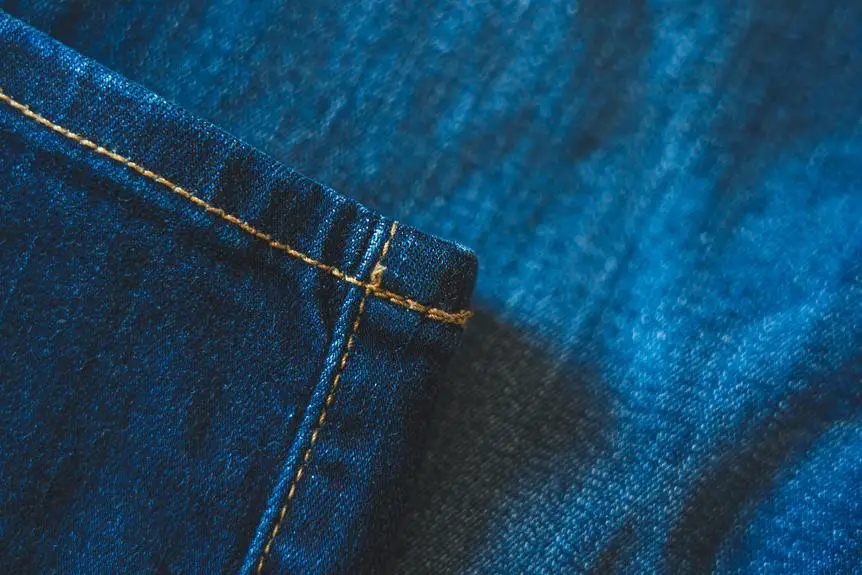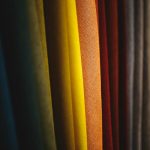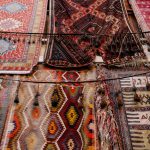When you consider fabric durability, taffeta often surprises many with its strength and resilience. Unlike more fragile options, taffeta stands up to the rigors of daily wear, maintaining its structure and elegance over time. You might not expect a fabric that looks so refined to be so tough. However, it's essential to understand what contributes to its durability and how it compares to other materials. As you explore this topic, you may find some unexpected insights that could change your perception of taffeta entirely.
Table of Contents
Understanding Taffeta Fabric
What makes taffeta fabric a popular choice for various garments and home decor is its unique texture and elegant sheen.
You'll notice that taffeta has a crisp, smooth feel that catches the light beautifully, giving garments and decor a sophisticated appearance. This fabric is often used for formal dresses, like ball gowns and bridesmaid dresses, as well as luxurious curtains and table linens.
When you wear or use taffeta, you'll appreciate how it holds its shape well, providing structure to your outfits or decor. It adds a touch of refinement, making it ideal for special occasions or upscale settings. You might find it's also lightweight, making it comfortable for wear while still being easy to drape and style.
However, it's essential to be aware that taffeta can be prone to wrinkling, so you might need to handle it carefully.
Despite this, its visual appeal and versatility in various applications make taffeta a go-to choice for anyone looking to elevate their fashion or interior design. Whether you're dressing up for an event or enhancing your living space, taffeta's charm is hard to resist.
Composition and Weaving Techniques
The unique texture and sheen of taffeta largely stem from its specific composition and weaving techniques, which play a significant role in defining its overall characteristics.
Taffeta is primarily made from silk, polyester, or nylon, each offering distinct qualities. Silk taffeta provides a luxurious feel and natural luster, while polyester and nylon variants are more affordable and durable.
The weaving technique used for taffeta is a plain weave, where threads cross over and under each other in a simple grid pattern. This method creates a tightly woven fabric that enhances its crispness and structure. The tightness of the weave contributes to taffeta's ability to hold shapes and resist wrinkles, making it ideal for formal garments like evening gowns and wedding dresses.
Additionally, the way the fibers are treated during production can affect the sheen and texture. Some taffeta fabrics undergo finishing processes that enhance their smoothness and shine, giving them a distinctive look.
Comparing Durability With Other Fabrics
When comparing taffeta's durability to other fabrics, you'll find it stands out for its ability to resist wear and tear, especially against more delicate materials like chiffon or silk. Taffeta's crisp texture and tight weave provide a robust structure that holds up under everyday use, making it ideal for formal wear, bridesmaid dresses, and even home décor.
In contrast, fabrics such as cotton or linen, while breathable and comfortable, often show signs of wear faster than taffeta. They can wrinkle easily and may require more frequent washing, which can lead to fading over time. Polyester, another popular fabric, offers decent durability, but it may not match taffeta's luxurious feel or crisp appearance.
If you're looking for something that combines elegance with resilience, taffeta should be at the top of your list. Its ability to maintain shape and resist fraying makes it a dependable choice for garments that need to look fresh and polished.
Common Misconceptions About Taffeta
Many people mistakenly believe that taffeta is only suitable for formal occasions, but its versatility makes it a great choice for a variety of applications. This misconception limits your options when it comes to using this elegant fabric. Taffeta is not just for evening gowns and wedding dresses; it can also be used for casual wear, home décor, and even accessories.
Another common belief is that taffeta is too stiff and uncomfortable. In reality, taffeta comes in various weights and finishes, allowing it to be soft and flowy or structured, depending on what you need. Additionally, some think taffeta is high-maintenance and difficult to care for, but many modern taffetas are machine washable and easy to maintain.
Here's a quick comparison to clarify:
| Misconception | Reality |
|---|---|
| Only for formal occasions | Versatile for many uses |
| Uncomfortable and stiff | Available in various textures |
| High-maintenance | Often machine washable |
| Limited design options | Available in many colors |
Practical Applications of Taffeta
Exploring taffeta's practical applications reveals its remarkable adaptability in fashion, home décor, and event planning.
In fashion, you'll often find taffeta in evening gowns, cocktail dresses, and formal wear. Its crisp texture and smooth finish give garments a structured silhouette, making it a favorite for special occasions. When you wear taffeta, you'll notice how it holds its shape beautifully, adding elegance to your look.
In home décor, taffeta can be utilized for curtains, cushion covers, and table runners. Its ability to resist wrinkling means you won't have to constantly press your drapes or cushions. Plus, the fabric's sheen enhances the aesthetic appeal of your living spaces, creating a sophisticated atmosphere.
Event planning also benefits from taffeta's versatility. You can use it for table linens, chair covers, and backdrops, elevating the overall theme of any gathering. The fabric's range of colors and patterns allows you to customize your décor to fit your vision perfectly. Whether you're dressing up for a wedding or adding flair to a birthday party, taffeta's durability and style will make your event unforgettable.
Maintenance Tips for Long-Lasting Taffeta
To keep your taffeta looking vibrant and fresh, you need to follow some essential maintenance tips.
Proper washing techniques, safe storage methods, and effective ironing practices can significantly extend the life of your fabric.
Let's explore how you can achieve that.
Proper Washing Techniques
Properly washing taffeta will help maintain its vibrant colors and crisp texture for years to come. Start by checking the care label; some taffeta fabrics may be dry clean only, while others can tolerate gentle washing.
If it's machine washable, use a delicate cycle with cold water to prevent damage. Avoid using harsh detergents, as they can fade the fabric. Instead, opt for a mild detergent specifically designed for delicate fabrics.
If you're hand-washing, fill a basin with cold water and add a small amount of detergent. Gently agitate the water, then submerge the taffeta. Swish it lightly for a few minutes, avoiding any scrubbing or twisting, as that can lead to creases or tears. Rinse thoroughly with cold water to remove all detergent residue.
Once washed, lay the taffeta flat on a clean, dry towel to absorb excess water. Avoid wringing it out. Instead, roll the towel with the fabric inside to gently squeeze out moisture.
Storing Taffeta Safely
Storing taffeta safely is essential for preserving its shape and vibrant colors over time. Improper storage can lead to creases, fading, or even damage to the fabric. Here are some simple tips to ensure your taffeta stays in excellent condition:
- Use breathable garment bags: Choose a cotton or muslin bag to protect your taffeta from dust while allowing it to breathe.
- Avoid plastic: Steer clear of plastic containers or bags, as they can trap moisture and lead to mildew.
- Store flat or on a hanger: If you hang your taffeta, opt for wide padded hangers to maintain its shape. If storing flat, place acid-free tissue paper between layers to prevent creasing.
Ironing and Pressing Tips
After ensuring your taffeta is stored correctly, keeping it wrinkle-free and looking its best requires a few straightforward ironing and pressing techniques. Start by checking the care label for specific instructions. Most taffeta can handle low to medium heat. Always use a pressing cloth, like a clean cotton or muslin fabric, to protect the surface of your taffeta from direct heat.
When you're ready to iron, turn the fabric inside out to prevent any shine or damage. Move the iron gently over the fabric without letting it sit in one spot for too long, as taffeta can scorch easily. If you're dealing with stubborn wrinkles, lightly steam the fabric instead of pressing it directly. You can also hang the garment in the bathroom while you take a hot shower—the steam will help release the wrinkles.
For delicate taffeta or intricate designs, consider using a fabric steamer for a gentler approach. Remember not to twist or wring the fabric when you're done; instead, hang it up to dry flat. By following these tips, you'll keep your taffeta looking fresh and vibrant for years to come!
Real-Life Experiences With Taffeta
Many people have shared their experiences with taffeta, highlighting its unique blend of beauty and practicality in various settings. You might find taffeta in elegant evening gowns or stunning bridesmaid dresses, where its crisp texture adds a touch of sophistication. But it's not just for formal occasions; you'll see it in home décor items like curtains and tablecloths, proving its versatility.
Here are some real-life scenarios where taffeta shines:
- A bride's unforgettable walk down the aisle, her taffeta gown flowing elegantly with each step.
- A lively outdoor wedding reception, where taffeta table runners catch the breeze, adding charm to the décor.
- A special anniversary dinner, where taffeta napkins elevate the dining experience and impress guests.
These experiences reinforce that taffeta isn't just visually appealing; it withstands the test of time, making it a favorite for many.
Whether it's the durability or the stunning appearance, taffeta continues to leave a lasting impression in your life.
Frequently Asked Questions
Is Taffeta Fabric Eco-Friendly or Sustainable?
Taffeta isn't typically considered eco-friendly or sustainable. Its production often involves synthetic materials and chemicals. If you're looking for sustainable options, you might want to explore fabrics made from organic or recycled sources instead.
How Does Taffeta React to Sunlight Exposure?
When taffeta's exposed to sunlight, it can fade and weaken over time. You should avoid prolonged exposure to direct sunlight to keep it looking vibrant and maintain its structural integrity for longer-lasting use.
Can Taffeta Be Recycled After Use?
You can recycle taffeta, but it depends on local facilities. Check if your recycling center accepts synthetic fabrics. If not, consider donating or repurposing items made from taffeta to reduce waste creatively.
What Are the Best Dyes for Taffeta Fabric?
When dyeing taffeta, you'll get the best results with acid dyes or reactive dyes. These options bond well with the fabric, ensuring vibrant, long-lasting colors that enhance your taffeta's appearance for any project.
Is Taffeta Suitable for Outdoor Use?
Taffeta isn't ideal for outdoor use since it can easily be damaged by moisture and UV rays. If you want something durable for outdoor settings, consider fabrics specifically designed to withstand the elements better.
- How Does Ring Spun Cotton Affect Garment Fit and Shape Retention? - August 13, 2024
- What Are the Challenges in Producing Ring Spun Cotton? - August 13, 2024
- Is Ring Spun Cotton Suitable for Plus-Size Clothing? - August 13, 2024







